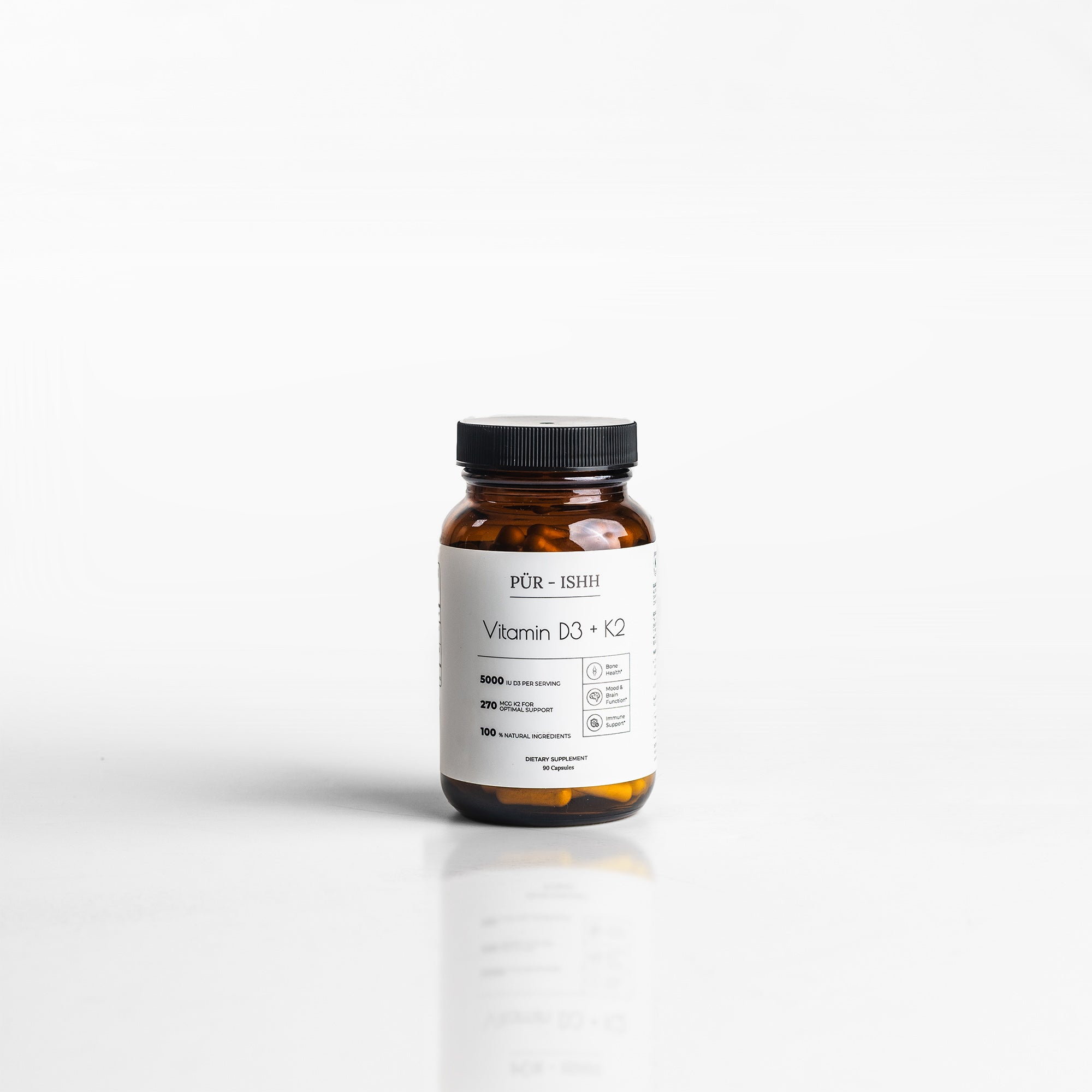Here's a stat that'll probably shock you: even if you're taking a vitamin D supplement religiously, you might be absorbing less than 30% of what's on the label. That's not a typo, most people are essentially flushing money down the drain with their current approach to vitamin D supplementation.
The problem isn't that you're not trying hard enough. The problem is that most vitamin D products on the market are formulated based on what's cheapest to manufacture, not what your body actually needs to properly absorb and use this crucial nutrient.
At Purishh, we've spent years researching and perfecting our approach to vitamin D, and what we've learned has completely changed how we think about supplementation. Today, we're going to share the science behind vitamin D absorption and show you exactly why our approach gets results when other products fall short.
The Absorption Problem Nobody Talks About
Let's start with the uncomfortable truth: vitamin D3 by itself is poorly absorbed by most people. The supplement industry knows this, but they keep selling isolated vitamin D3 because it's cheap and easy to manufacture.
Your body doesn't naturally encounter vitamin D in isolation. When your skin produces vitamin D from sunlight, it happens alongside a complex symphony of other nutrients and cofactors that help your body actually use what it's making. Taking isolated vitamin D3 is like trying to start your car with just a key, you need the whole system working together.
Here's what most supplements get wrong:
Fat-soluble vitamin without proper fats: Vitamin D is fat-soluble, which means it needs to be taken with fats to be absorbed. Most supplements either contain no fats or use cheap oils that don't optimize absorption.
Missing essential cofactors: Your body needs vitamin K2, magnesium, and other nutrients to properly transport and utilize vitamin D. Without these, you're creating expensive urine, not building stronger bones and immunity.
Poor timing and dosing: Taking a week's worth of vitamin D once a week might seem convenient, but it's not how your body wants to receive nutrients.
The Purishh Approach: Vitamin D the Way Nature Intended
We looked at this problem and decided to solve it properly. Our Vitamin D formula isn't just about getting vitamin D into your system, it's about creating the optimal conditions for your body to actually use it effectively.
Grass-fed sources: Our vitamin D3 comes from grass-fed animals, not the synthetic versions made from lanolin that most companies use. Grass-fed sources provide a more bioactive form of vitamin D3 along with naturally occurring cofactors.
Strategic fat pairing: We include specific fats that research shows optimize vitamin D absorption. Not just any fats, the right fats, in the right ratios, sourced from grass-fed sources that provide additional fat-soluble vitamins.
Essential cofactor inclusion: Our formula includes vitamin K2 (in the MK-7 form, which has the longest half-life) and magnesium in forms that are highly bioavailable. This isn't just throwing ingredients together, it's creating a synergistic system.
The Science of Better Absorption
Let's talk about what actually happens when you take vitamin D the right way versus the wrong way.
When you take isolated vitamin D3 on an empty stomach (like most people do), here's what happens: your body absorbs maybe 20-30% of what you took. The rest literally gets eliminated as waste. Even worse, if you're deficient in cofactors like K2 and magnesium, that small amount you did absorb might not be utilized effectively.
When you take vitamin D with the right fats and cofactors, absorption can increase by 300-500%. More importantly, your body can actually use what it absorbs to build stronger bones, support immune function, and maintain healthy hormone levels.
One study published in the Journal of the Academy of Nutrition and Dietetics found that taking vitamin D with avocado (which contains the right types of fats) increased absorption by 3-5 times compared to taking it without fat. Our formula essentially built-in this absorption advantage.
Timing and Dosing: Why Consistency Beats Megadoses
Here's another place most people go wrong: they think more is always better with vitamin D. We've had customers come to us taking 10,000 IU once a week, wondering why their blood levels aren't improving.
Your body prefers steady, consistent vitamin D intake over large, infrequent doses. Think about it, if you were getting vitamin D from sunlight, you'd be getting modest amounts daily, not massive amounts once a week.
The optimal approach: 2,000-4,000 IU daily with a fat-containing meal. This mimics how your body naturally processes vitamin D and leads to better, more stable blood levels over time.
What to Look for in Your Current Supplement
If you're currently taking a vitamin D supplement, here's how to evaluate whether it's actually working for you:
Check your blood levels: Get a 25-hydroxy vitamin D blood test. Optimal levels are between 40-60 ng/mL, not just "above deficient." If you've been supplementing for 3+ months and aren't in this range, your supplement isn't working.
Read the ingredients: Does it contain vitamin K2? What about magnesium? If it's just isolated vitamin D3, you're missing crucial pieces.
Consider the source: Is it from grass-fed sources or synthetic? Grass-fed provides better bioactivity and naturally occurring cofactors.
Look at the fats: If there are no fats included, you need to be very intentional about taking it with meals that contain healthy fats.
The Real-World Results
We track customer results religiously, and the difference is dramatic. Customers switching to our approach from isolated vitamin D3 supplements typically see their blood levels improve by 40-70% within 90 days, even when taking similar amounts of vitamin D.
More importantly, they report better energy, improved mood (especially during winter months), and fewer seasonal illnesses. Sarah from Michigan told us: "I was taking 5,000 IU of vitamin D daily for two years and my levels barely budged. Three months with Purishh's approach and I'm finally in the optimal range for the first time in years."
Beyond Supplementation: Supporting Your Body's Natural Production
Even the best supplement can't completely replace your body's natural vitamin D production. Here are ways to maximize both:
Strategic sun exposure: 15-20 minutes of midday sun on bare skin (no sunscreen) several times per week, when possible. Your skin produces vitamin D most efficiently when the sun is directly overhead.
Support your gut health: Vitamin D absorption happens in your intestines. Poor gut health directly impacts how well you absorb fat-soluble vitamins. Consider adding fermented foods or a quality probiotic.
Address mineral deficiencies: Zinc, magnesium, and boron all play roles in vitamin D metabolism. A comprehensive approach addresses these foundational nutrients.
The Investment That Actually Pays Off
Here's the reality: you can spend $10-15 per month on cheap vitamin D3 that barely moves the needle on your blood levels, or you can invest in a properly formulated approach that actually delivers results.
When our customers track their progress with blood tests, they consistently see the difference. But more importantly, they feel the difference, better energy, improved mood, stronger immunity, and the confidence that comes from knowing their supplement is actually working.
Quality vitamin D supplementation, done right, becomes one of the best investments you can make in your long-term health. The key is doing it right from the start, not trying to fix deficiencies with the wrong approach for years.
That's the Purishh difference: we don't just sell supplements, we solve the real problems that keep other supplements from working.




